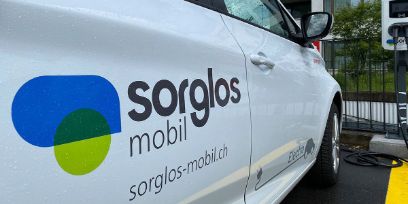- News
Despite obstacles: «Sorglos mobil» project provides insights for a possible mobility transition
13.04.2023 A convincing offer is necessary to encourage residents to leave their cars behind and to use new mobility and sharing services instead. This was demonstrated by the “Seamlessly Mobile” pilot project on the Suurstoffi site in Risch-Rotkreuz. Researchers from BFH provided scientific support for the project.
Over the last two years, the Suurstoffi site in Risch-Rotkreuz has served as a testing ground for a new mobility service. “What would it take for people living in a residential area to leave their cars behind and use shared forms of mobility instead?” was the core question of the pilot project. Residents were able to test various mobility services bundled into a single combined subscription. Vehicles were available both on and off the Suurstoffi site, as was public transport. Subscriptions with sharing services for cars, e-bikes and cargo bikes as well as a public transport credit offered attractive conditions.
Shared mobility sparks interest
Many residents were open to the project and used the vehicles available on an individual basis, but they were reluctant to take out a combined subscription. Over the full duration of the project, 16 people subscribed, which was below expectations. The project was complicated by the fact that it took place during the pandemic, when both public transport and shared mobility suffered. However, the project partners gained the following interesting insights:
- Mobility bundles, especially quotas, offer huge potential for reducing energy demand and carbon emissions in the transport sector. The effect is greater with a subscription that includes credit rather than with a “pay-as-you-go” model.
- For residents to leave their cars behind and use shared mobility, incentives are required that appeal to them on both a rational and an emotional level, as well as mandatory framework conditions. This could be a reduction in the number of parking spaces, for example. The project showed that residents change behaviour towards public and shared mobility in their leisure time first and then when commuting to work.
- Interest in shared mobility on the doorstep (e-cars, e-bikes and cargo bikes) was also sparked among car owners on the Suurstoffi site. However, residents mainly used those offers individually and were very reluctant to take out subscriptions.
- Digitization and apps for customers play a central role in enabling them to enjoy more sustainable door-to-door experiences without using their own cars. Data transfer standards at a national level are an important prerequisite for this.
- An app that bundles the various mobility services has to be more than just a resale platform. Customers need to be completely convinced before they will abandon the individual mobility apps they already use.
The study design had to be adapted
Researchers at the Institute for Urban Development Infrastructure ISI of Bern University of Applied Sciences BFH provided scientific support for the project. The researchers had to adapt the original study concept due to the limited number of passes purchased. Thus, the effects of the new service on the mobility behavior of the test persons, and thus on energy consumption, emissions and neighborhood traffic, were no longer primarily investigated. Instead, the researchers focused on why the project had not received a more favourable response. By means of questionnaire, statements about the mobility behavior of the Suurstoffi residents and possible obstacles to the pilot project could be highlighted. In addition to researchers from BFH, a team from Lucerne University of Applied Sciences and Arts (HSLU) was also involved in the development of the questionnaire. As part of the SWEET funding programme of the Swiss Federal Office of Energy (SFOE), HSLU scientists are conducting a long-term study over a period of seven years on how to achieve a sustainable and efficient way of living while at the same time improving the quality of life on plots and in settlements. The results of the «Sorglos mobil» project are also included in this study.
Joint project
“Seamlessly Mobile” was a joint pilot projectTarget not accessible by PostBus, Zug Estates, Mobility Cooperative and the TCS Mobility Academy (carvelo2go). The Federal Office of Transport (FOT) financially supported the project as part of the Swiss Confederation’s Energy Strategy for Public Transport 2050 (ESPT).
You can read the final report here (in German)
